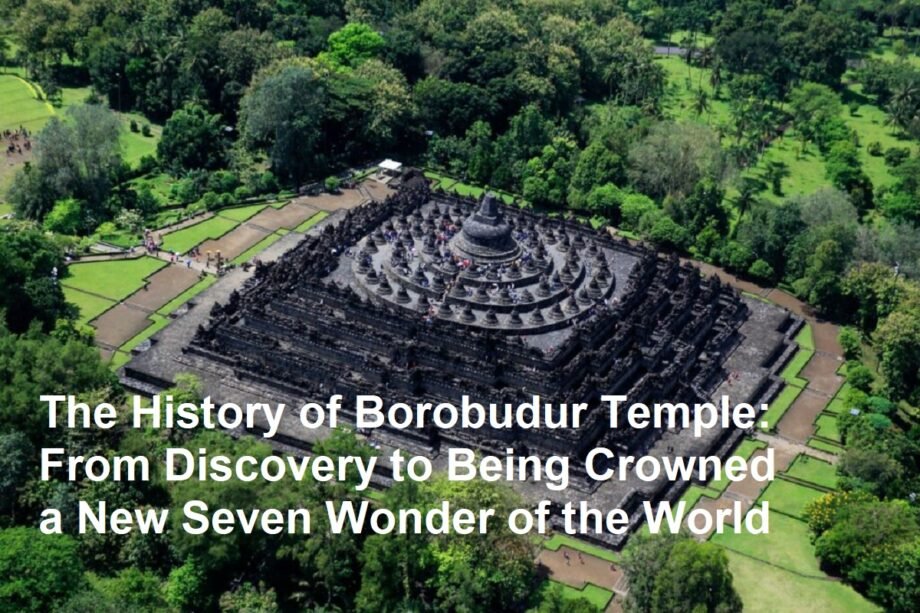Introduction: The Magnificent Borobudur Temple
Borobudur Temple, located in Central Java, Indonesia, is one of the most iconic and awe-inspiring monuments in the world. This ancient Buddhist temple is not only a masterpiece of architecture and art but also a symbol of Indonesia’s rich cultural heritage. Its journey from being a forgotten relic to becoming officially recognized as one of the New Seven Wonders of the World is a fascinating story that reflects the temple’s historical, cultural, and spiritual significance.
The Discovery of Borobudur: Unearthing a Lost Treasure
Borobudur was built in the 9th century during the reign of the Sailendra Dynasty. For centuries, it was buried under volcanic ash and dense jungle, hidden from the world. The temple’s rediscovery in the early 19th century marked a turning point in the appreciation of Southeast Asian history and architecture.
- Initial Rediscovery : In 1814, Sir Thomas Stamford Raffles, the British governor of Java, learned about the existence of the temple from local villagers. He commissioned a survey and excavation led by Dutch engineer H.C. Cornelius.
- Excavation and Restoration : The temple was partially excavated, revealing its intricate stone carvings and massive structure. However, it wasn’t until the early 20th century that more extensive restoration efforts began, led by the Dutch colonial government and later by UNESCO.
Architectural and Cultural Significance
Borobudur is a marvel of ancient engineering and artistry. It is the largest Buddhist temple in the world, built as a massive stupa with nine stacked platforms—six square and three circular—topped by a central dome. The temple is adorned with over 2,600 relief panels and 504 Buddha statues.
- Symbolism: The design of Borobudur represents the Buddhist cosmology, illustrating the path from the earthly realm to enlightenment.
- Reliefs: The detailed reliefs depict stories from Buddhist texts, daily life in 8th-century Java, and philosophical teachings.
- Pilgrimage Site: For centuries, Borobudur has been a pilgrimage destination for Buddhists, especially during Vesak, the celebration of Buddha’s birth, enlightenment, and death.
Borobudur’s Journey to Global Recognition
Borobudur’s significance was recognized internationally in the 20th century, culminating in its designation as a UNESCO World Heritage Site in 1991. This recognition helped preserve the temple and promote it as a cultural landmark.
- UNESCO World Heritage Site : The inscription highlighted Borobudur’s outstanding universal value as a cultural and historical monument.
- Conservation Efforts : International cooperation has ensured ongoing restoration and protection against environmental threats such as erosion and earthquakes.
Borobudur as One of the New Seven Wonders of the World
In 2007, Borobudur was officially named one of the New Seven Wonders of the World, a global campaign to recognize the most extraordinary human-made monuments.
| Year | Event | Significance |
| 1814 | Rediscovery by Sir Thomas Stamford Raffles | Brought Borobudur back to global attention |
| Early 1900s | Restoration by Dutch colonial government | Preserved the temple’s structure and art |
| 1991 | UNESCO World Heritage Site designation | International recognition and protection |
| 2007 | Named New Seven Wonders of the World | Global acknowledgment of its cultural value |
This accolade boosted tourism and global awareness, making Borobudur a symbol of Indonesia’s cultural pride and a must-visit destination for travelers worldwide.
Final Thoughts: Why Borobudur Matters Today
Borobudur is more than just an ancient temple; it is a testament to human creativity, spirituality, and resilience. Its discovery and preservation have allowed millions to connect with a profound cultural legacy. As one of the New Seven Wonders of the World, Borobudur continues to inspire awe and respect, reminding us of the importance of protecting our shared heritage.









